-
 Bitcoin
Bitcoin $115800
-2.47% -
 Ethereum
Ethereum $3690
1.19% -
 XRP
XRP $3.105
-1.91% -
 Tether USDt
Tether USDt $0.9999
-0.07% -
 BNB
BNB $771.0
0.19% -
 Solana
Solana $179.9
-3.54% -
 USDC
USDC $0.9998
-0.03% -
 Dogecoin
Dogecoin $0.2291
-3.40% -
 TRON
TRON $0.3140
0.81% -
 Cardano
Cardano $0.8007
-1.24% -
 Hyperliquid
Hyperliquid $42.92
-0.44% -
 Stellar
Stellar $0.4212
-2.16% -
 Sui
Sui $3.730
0.03% -
 Chainlink
Chainlink $18.06
0.03% -
 Bitcoin Cash
Bitcoin Cash $546.6
5.08% -
 Hedera
Hedera $0.2438
0.55% -
 Avalanche
Avalanche $23.57
-0.81% -
 Litecoin
Litecoin $114.2
1.04% -
 UNUS SED LEO
UNUS SED LEO $8.970
-0.35% -
 Shiba Inu
Shiba Inu $0.00001363
-0.16% -
 Toncoin
Toncoin $3.136
-0.89% -
 Ethena USDe
Ethena USDe $1.001
-0.04% -
 Uniswap
Uniswap $10.30
1.42% -
 Polkadot
Polkadot $4.013
-0.06% -
 Monero
Monero $324.8
0.87% -
 Dai
Dai $0.9999
-0.04% -
 Bitget Token
Bitget Token $4.509
-1.38% -
 Pepe
Pepe $0.00001226
-2.60% -
 Aave
Aave $291.8
1.34% -
 Cronos
Cronos $0.1294
2.19%
How to deal with the monthly Bollinger opening + weekly line breaking through the lower track + daily line new low with large volume?
A monthly Bollinger opening, weekly breakdown, and daily new low on high volume signal strong bearish momentum—confirm with volume, RSI, and multi-timeframe analysis before acting.
Jul 24, 2025 at 09:22 am
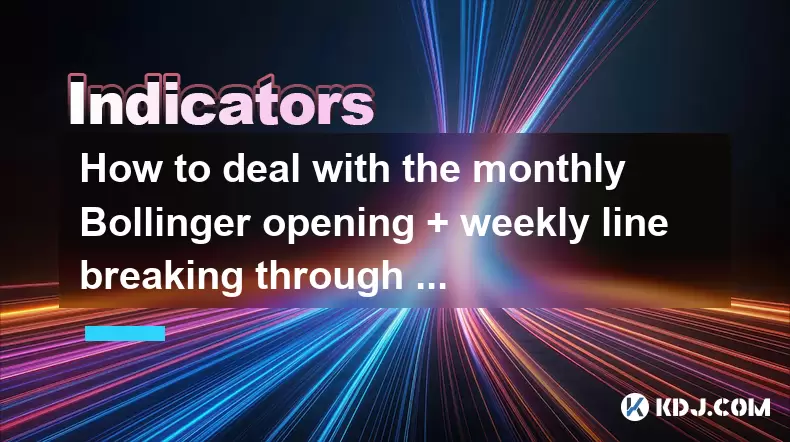
Understanding the Bollinger Bands Monthly Opening Signal
The monthly Bollinger opening refers to a scenario where the price of a cryptocurrency moves beyond the upper or lower band on a monthly timeframe. When this occurs on the lower side, it often indicates extreme bearish sentiment. The Bollinger Bands consist of a moving average (typically 20-period) with two standard deviation bands above and below. A monthly close outside the lower band suggests that the market is oversold on a long-term basis. However, such signals should not be interpreted in isolation. The monthly Bollinger opening to the downside can signal panic selling or capitulation, but it may also precede a short-term bounce or continuation of a downtrend depending on broader market conditions.
Traders must analyze volume, momentum indicators, and alignment with higher timeframes. A breakdown below the monthly lower band with increasing volume strengthens the bearish case. The psychological impact of such a move often leads to increased fear among holders, potentially accelerating selling pressure. It is critical to assess whether this opening is part of a structural breakdown or a temporary overreaction.
Implications of Weekly Price Breaking Below the Lower Bollinger Band
When the weekly closing price breaks through the lower Bollinger Band, it confirms heightened volatility and bearish momentum. This event suggests that short-term traders are aggressively selling, and the asset is trading at statistically low levels relative to its recent average. The weekly timeframe carries more weight than daily or hourly charts because it filters out noise and reflects institutional and swing trader behavior.
To verify the strength of this signal:
- Confirm that the close, not just an intraweek low, is below the band.
- Check the volume during the weekly candle formation—a spike in volume increases the reliability of the breakdown.
- Examine the position of the 20-week simple moving average (SMA) and whether it is sloping downward, indicating a bearish trend.
- Use the Relative Strength Index (RSI) on the weekly chart; an RSI below 30 may suggest oversold conditions, but in strong downtrends, oversold can persist.
This weekly breakdown, combined with the monthly Bollinger opening, creates a multi-timeframe confirmation of bearish dominance. It warns of possible continuation unless strong reversal patterns emerge.
Analyzing Daily New Lows with High Volume
A daily new low accompanied by large volume is one of the most significant bearish confirmation signals. It indicates that a significant number of market participants are selling at lower prices, potentially including institutional holders or algorithmic traders. This kind of volume surge often marks distribution phases or capitulation events.
To analyze this properly:
- Compare the current day’s volume to the 30-day average volume. If it’s 2–3 times higher, it’s considered large volume.
- Look at the candlestick pattern: a long red candle with minimal upper wick shows strong selling pressure.
- Check whether the new low breaks through prior support levels or psychological price points (e.g., $10, $100).
- Use on-chain data (for cryptocurrencies) such as exchange inflows or whale movements to assess if large entities are dumping.
This daily action, when aligned with the monthly and weekly bearish signals, suggests that downward momentum is accelerating. Traders should avoid catching the falling knife unless specific reversal conditions are met.
Strategic Responses to the Triple Bearish Confirmation
Given the convergence of monthly Bollinger opening, weekly lower band breakdown, and daily new low with high volume, traders must adopt defensive or counter-trend strategies depending on their risk profile.
For active traders:
- Short positions can be initiated with tight stop-loss orders above the weekly lower band or recent swing high.
- Use futures or perpetual contracts with leverage, but only with strict risk management—limit position size to 1–3% of capital.
- Consider inverse ETFs or put options if available on the asset (e.g., on platforms like Deribit for Bitcoin).
- Avoid buying the dip until at least two timeframes show signs of stabilization.
For long-term holders:
- Evaluate portfolio allocation and consider reducing exposure if the asset breaks key structural supports.
- Set automatic stop-loss triggers on exchanges to minimize emotional decisions.
- Monitor for divergence in momentum indicators (e.g., MACD or RSI) across timeframes as early reversal clues.
Risk management is paramount. The combination of these signals increases the probability of extended downside.
Technical Confirmation and Monitoring Tools
To validate and monitor this bearish setup, use the following tools and steps:
- Overlay Bollinger Bands on monthly, weekly, and daily charts using the same parameters (20-period SMA, 2 standard deviations).
- Enable volume profile indicators to identify high-volume nodes and potential support/resistance zones.
- Apply MACD on all three timeframes to check for bearish crossovers or accelerating momentum.
- Use Fibonacci extensions from the last major swing high to project potential downside targets.
- Integrate on-chain analytics tools like Glassnode or CryptoQuant to monitor exchange reserves, miner flows, and realized price.
Set up price alerts on exchanges or trading platforms for key levels:
- Break below the daily low on increased volume.
- Weekly close back above the lower Bollinger Band (possible exhaustion).
- Volume drying up after a spike (potential reversal signal).
Automated bots can be programmed to scan for these conditions and notify or execute trades based on predefined rules.
Frequently Asked Questions
What does it mean when all three timeframes (monthly, weekly, daily) show bearish Bollinger signals simultaneously?
This alignment indicates a powerful downtrend with momentum accelerating across short, medium, and long-term horizons. It reflects widespread selling pressure and often precedes extended bear markets or deep corrections. Such confluence reduces the likelihood of a quick reversal.
Should I short the asset immediately when these conditions appear?
Not necessarily. While the signals are bearish, entering a short position requires confirmation of continuation. Wait for a retest of the weekly lower band as resistance or a failed bounce. Always use stop-loss orders and avoid over-leveraging.
Can this setup ever lead to a strong reversal instead of further downside?
Yes, in cases of capitulation, such extreme signals can mark the end of a sell-off. Look for a sharp volume spike followed by a narrow-range candle or a bullish engulfing pattern on the daily chart. RSI divergence on the weekly chart may also hint at exhaustion.
How do I differentiate between a breakdown and a bear trap in this scenario?
A bear trap typically involves a false breakdown below the lower Bollinger Band with low volume, followed by a quick recovery above the band. A true breakdown sustains below the band with high volume and continued follow-through selling in subsequent periods.
Disclaimer:info@kdj.com
The information provided is not trading advice. kdj.com does not assume any responsibility for any investments made based on the information provided in this article. Cryptocurrencies are highly volatile and it is highly recommended that you invest with caution after thorough research!
If you believe that the content used on this website infringes your copyright, please contact us immediately (info@kdj.com) and we will delete it promptly.
- Pump, Bonk, Buyback: A Wild Ride in Crypto Town!
- 2025-07-25 19:10:12
- Punisher Coin, Dogecoin, Shiba Inu: Meme Coin Mania in the 2025 Crypto Landscape
- 2025-07-25 19:10:12
- Celestia's Token Control: Buyback & Staking Overhaul in Focus
- 2025-07-25 19:50:11
- Altcoins, Bitcoin, and Crypto Coins: What's Hot in the NYC Crypto Scene?
- 2025-07-25 19:55:52
- Litecoin Price Breakout Imminent? Rally Potential Explored!
- 2025-07-25 17:30:12
- Ether ETFs Surge, Bitcoin Wobbles: Is an ETH Breakout Imminent?
- 2025-07-25 16:50:12
Related knowledge

How to interpret that the KDJ D line is downward for a long time but the price is sideways?
Jul 25,2025 at 07:00pm
Understanding the KDJ Indicator and Its ComponentsThe KDJ indicator is a momentum oscillator widely used in cryptocurrency trading to assess overbough...

What does it mean that the KDJ indicator forms a double bottom at a low level?
Jul 25,2025 at 05:08pm
Understanding the KDJ Indicator in Cryptocurrency TradingThe KDJ indicator is a momentum oscillator widely used in cryptocurrency trading to identify ...
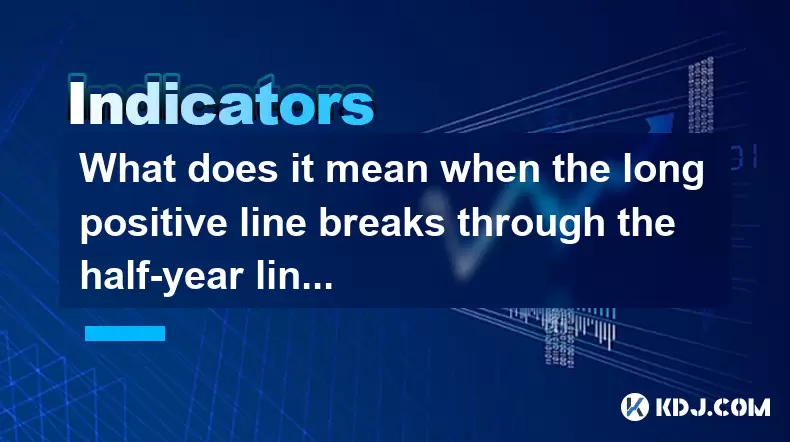
What does it mean when the long positive line breaks through the half-year line and then steps back?
Jul 25,2025 at 06:49pm
Understanding the Long Positive Line in Candlestick ChartsIn the world of cryptocurrency trading, candlestick patterns play a vital role in technical ...
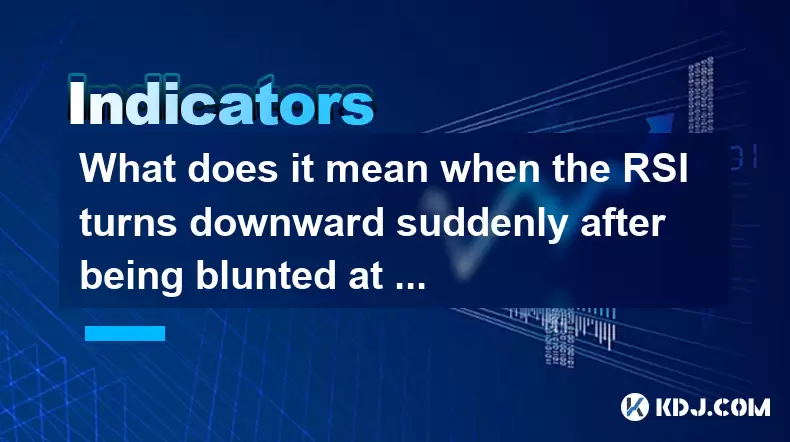
What does it mean when the RSI turns downward suddenly after being blunted at a high level?
Jul 25,2025 at 04:00pm
Understanding the RSI and Its Role in Technical AnalysisThe Relative Strength Index (RSI) is a momentum oscillator that measures the speed and change ...
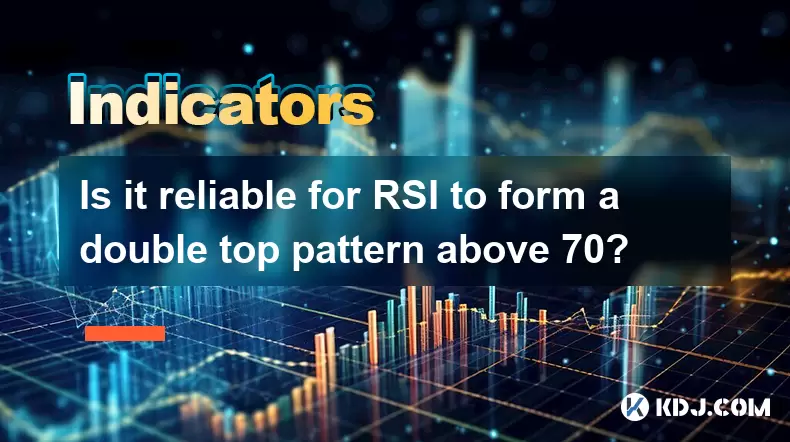
Is it reliable for RSI to form a double top pattern above 70?
Jul 25,2025 at 04:49pm
Understanding the RSI Indicator and Its Role in Technical AnalysisThe Relative Strength Index (RSI) is a momentum oscillator that measures the speed a...
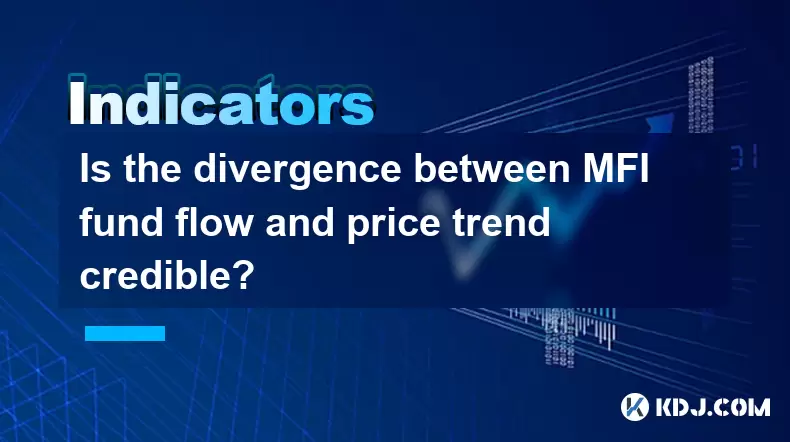
Is the divergence between MFI fund flow and price trend credible?
Jul 25,2025 at 12:01pm
Understanding MFI and Fund Flow in Cryptocurrency MarketsThe Money Flow Index (MFI) is a technical oscillator that combines price and volume to assess...

How to interpret that the KDJ D line is downward for a long time but the price is sideways?
Jul 25,2025 at 07:00pm
Understanding the KDJ Indicator and Its ComponentsThe KDJ indicator is a momentum oscillator widely used in cryptocurrency trading to assess overbough...

What does it mean that the KDJ indicator forms a double bottom at a low level?
Jul 25,2025 at 05:08pm
Understanding the KDJ Indicator in Cryptocurrency TradingThe KDJ indicator is a momentum oscillator widely used in cryptocurrency trading to identify ...

What does it mean when the long positive line breaks through the half-year line and then steps back?
Jul 25,2025 at 06:49pm
Understanding the Long Positive Line in Candlestick ChartsIn the world of cryptocurrency trading, candlestick patterns play a vital role in technical ...

What does it mean when the RSI turns downward suddenly after being blunted at a high level?
Jul 25,2025 at 04:00pm
Understanding the RSI and Its Role in Technical AnalysisThe Relative Strength Index (RSI) is a momentum oscillator that measures the speed and change ...

Is it reliable for RSI to form a double top pattern above 70?
Jul 25,2025 at 04:49pm
Understanding the RSI Indicator and Its Role in Technical AnalysisThe Relative Strength Index (RSI) is a momentum oscillator that measures the speed a...

Is the divergence between MFI fund flow and price trend credible?
Jul 25,2025 at 12:01pm
Understanding MFI and Fund Flow in Cryptocurrency MarketsThe Money Flow Index (MFI) is a technical oscillator that combines price and volume to assess...
See all articles

























































































